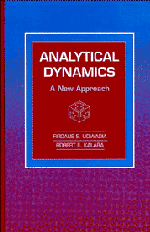Book contents
AFTERWORD
Published online by Cambridge University Press: 22 March 2010
Summary
This book primarily deals with developing the equations of motion for mechanical systems. It is a problem which was first posed at least as far back as Lagrange, over 200 years ago, and has been vigorously worked on since by many physicists and mathematicians. The list of scientists who have contributed and attempted this problem is truly staggering. A recent monograph on the subject by Neimark and Fufaev lists more than 500 recent references.
The first major step in the understanding of constrained motion was taken by Lagrange when he formulated and developed the technique of using, what are called today, the Lagrange multipliers. The next step took about a century in the making when Gibbs and Appell developed the Gibbs–Appell approach in the late eighteen hundreds. As mentioned in Pars's book (written in 1965) this approach is considered by most to provide the simplest and most comprehensive way of setting up the equations of motion for systems with nonintegrable constraints. In 1964, P. A. M. Dirac attempted to solve the problem anew and, for Hamiltonian systems with singular Lagrangians, developed a procedure for obtaining the equations of motion for constrained systems by ingeniously extending the concept of a Poisson bracket. Dirac considered constraints which were not explicitly dependent on time.
Dirac's approach has not been discussed in this book. It is well documented in advanced treatises on analytical mechanics and may be found in the list of references that we have provided; besides, it requires background material which would go well beyond an introductory text in mechanics.
- Type
- Chapter
- Information
- Analytical DynamicsA New Approach, pp. 259 - 260Publisher: Cambridge University PressPrint publication year: 1996
- 1
- Cited by

